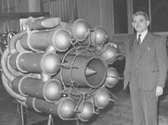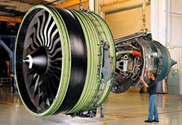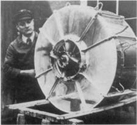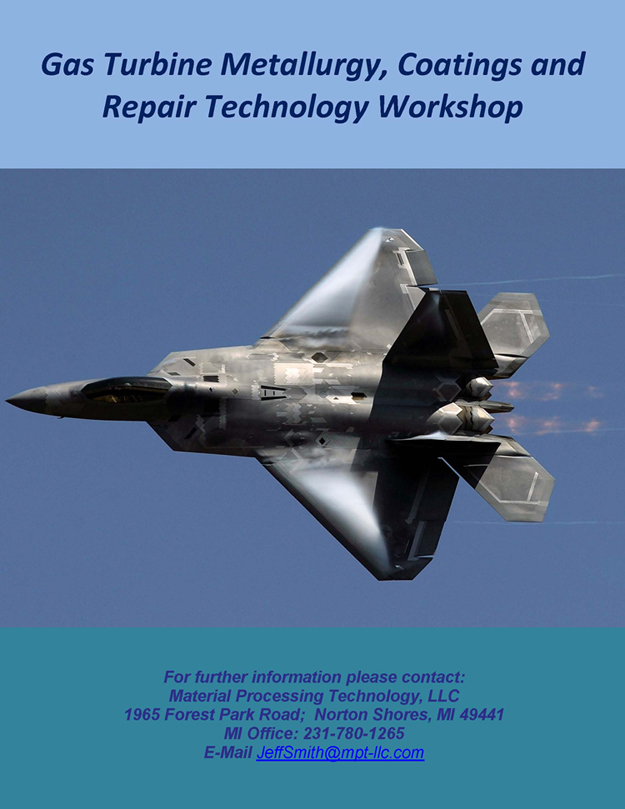

|
|
|
|
|
|
|
|
|
|
|
|
|
|
|
|
Training Courses |
|||||
|
|
|
|
|||
|
|
|||||
Course OverviewThe gas turbine is one of the most technologically advanced energy conversion devices. The first working models were introduced in 1939 in both aviation and in electric power production and had turbine inlet temperatures on the order of 1100 F and employed uncooled, heat resisting steel turbine blades. Today turbine inlet temperatures are in the range of 2700 F (1500 C) for the G & H class utility combustion turbines and in excess of 3000 F (1650 C) for commercial flight engines. These remarkable increases in the gas turbine firing temperature have been made possible in part by substantial advances in hot section airfoil materials, coatings and manufacturing technology during the past seventy years. This workshop will discuss the development history, manufacturing processes, application and refurbishment of the high temperature materials and coatings used in gas turbine engines with particular emphasis on hot section superalloy component manufacture and refurbishment. The metallurgy of nickel and cobalt based superalloys will be discussed and the many steps involved in investment casting manufacture, from wax pattern & ceramic core production, shell build, equiaxed, DS or single crystal vacuum casting and post cast operations will be reviewed. This will include review of advances in cooling configurations, casting imperfections, inspection methods and general acceptance criteria. Specific challenges related to making large F, G & H-class components and sophisticated air cooled, single crystal aero-engine airfoils will be noted. The widespread use of thermal barrier coatings has brought great focus to the issue of coating selection. The various types of gas turbine hot section coatings, their selection criteria and manufacturing method used will be discussed. The benefits of repair and refurbishment of engine run parts is well established. The increased complexity and high replacement cost of hot section components has placed greater importance on development of innovative component repair schemes. Participants will learn methods of assessing component damage experienced from service exposure, typical degradation modes observed and the techniques used to analyze the remaining life of components removed from service. The various component repair technologies utilized to restore components will be discussed in detail (ie dimensional checks, coating removal techniques, HIP and rejuvenation heat treatments, weld repair, diffusion brazing processes and component re-coating) as will quality assurance methods and procedures to verify the refurbished components meet industry standards. The workshop includes many case study examples of component refurbishment and the last section is devoted to a workshop where attendees develop component repair solutions. Participants are encouraged to submit questions in advance regarding repair issues faced in their jobs. Learning ObjectivesAfter completing the course the participants should be able to explain: 1. What makes superalloys especially suited for gas turbine components 2. Understanding of the distinction between conventional casting and directional solidification 3. How different damage mechanisms (oxidation, corrosion, erosion) affect the component 4. Advantages & disadvantages of the many types of protective coatings 5. How high cycle fatigue & low cycle fatigue damage is caused, prevented, and repaired 6. Various heat treatments used in repairs, and why they are important 7. Critical quality control steps in component manufacture and repair 8. How to reliably extend the service life of valuable components Who Should Enroll?Typically technical staff, engineers and technicians responsible for various aspects of gas turbine design, upgrade, manufacture, repair, analysis, operations, or maintenance will attend. A must for GT repair shop personnel, insurance companies, coatings suppliers, GT OEM designers and technical staff. Course HighlightsThis seminar will cover superalloy materials, airfoil manufacture, protective coatings, component damage experienced from service exposure, techniques used to analyze the remaining life of components removed from service, component repair technologies, and quality assurance of repairs. The seminar includes many case study examples and the last section of the seminar is devoted to a workshop where attendees develop component repair solutions. Participants are encouraged to contact the instructors prior to the course with potential applications or problems that can be discussed as case studies. Course Outline · Gas Turbine Overviewo Gas Turbine Engine Designs o Typical Gas Turbine Components, Materials and Coatings o Gas Turbine Airfoil Materials, Coatings and Airfoil Design Trends · Materials and Metallurgyo Superalloy Metallurgy o Evolution of Superalloy Materials Technology o Production of Superalloys o Investment Casting of Equiax, DS and Single Crystal Airfoils o NDT Inspection, Criteria and Acceptance Standards · Gas Turbine Coatingso Superalloy Surface Stability o Comparison of Oxidation/Corrosion protection o Manufacturing Methods and Requirements o Diffusion vs. Overlay Coatings o Thermal Barrier Coatings · Degradation of Gas Turbine Componentso Metallurgical Effects of Service o Creep o High Cycle Fatigue o Low Cycle Fatigue o Environmental Degradation · Why repair and refurbish parts?o Cost Benefit of Repairs o Repair Market Trends o The Future for Industrial Frame GT Repairs · Component Evaluation: The evaluation of used components and determination of the repair/refurbishment process will be discussed.o Timing and selection of components for analysis o Micro structural analysis o Mechanical testing –Stress Rupture bars o Coating Evaluation o Hot Corrosion Attack o Failure Analysis o Component Management Program
o
Determine Damage
Mechanisms, the Extent of Damage, Root Cause of Damage, and
· Refurbishment & Repair Processes: Procedures and techniques used to restore components to industry standardso Typical Damage o Coating Stripping o Dimensional Checks o Re-Coating Selection and Processes o HIP and Rejuvenation Heat Treatments o Superalloy Weld Processes o Diffusion Brazing · Quality Assurance: Methods and procedures to verify components meet industry standardso QA Certification o Quality Plan o QA Inspections o NDE Defect Criteria o Dimensional Specification o NDE Inspections · Case Studies & Problem Solving:
o
Case studies presented by
the instructors to illustrate the process of component repair &
· Round Table Discussion:o Round table discussion regarding the latest repair trends and student questions.
|
|||||
|
|
|||||
|
|
|||||
| © Copyright 2010. Material Processing Technology, LLC. | Designed by K.A. Taylor & Associates |



